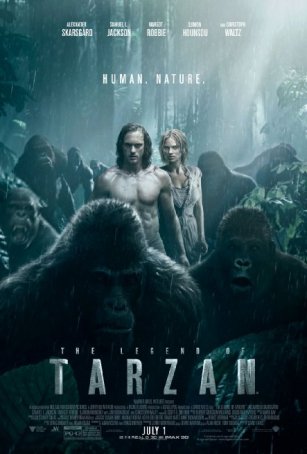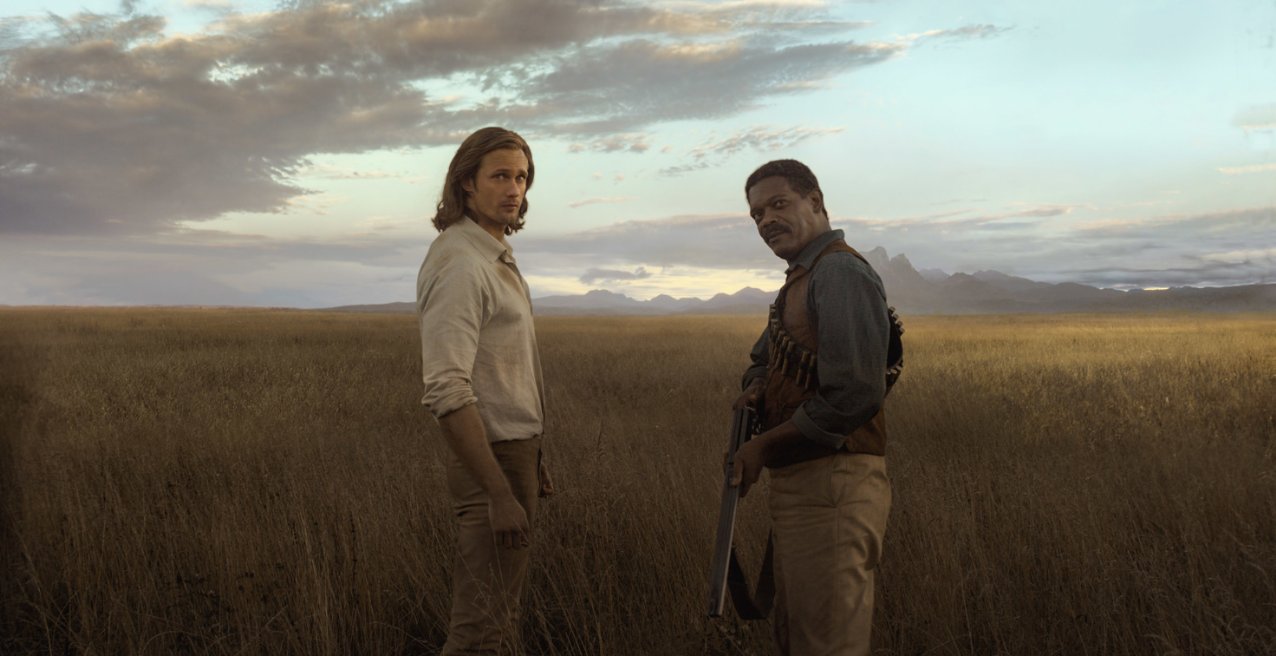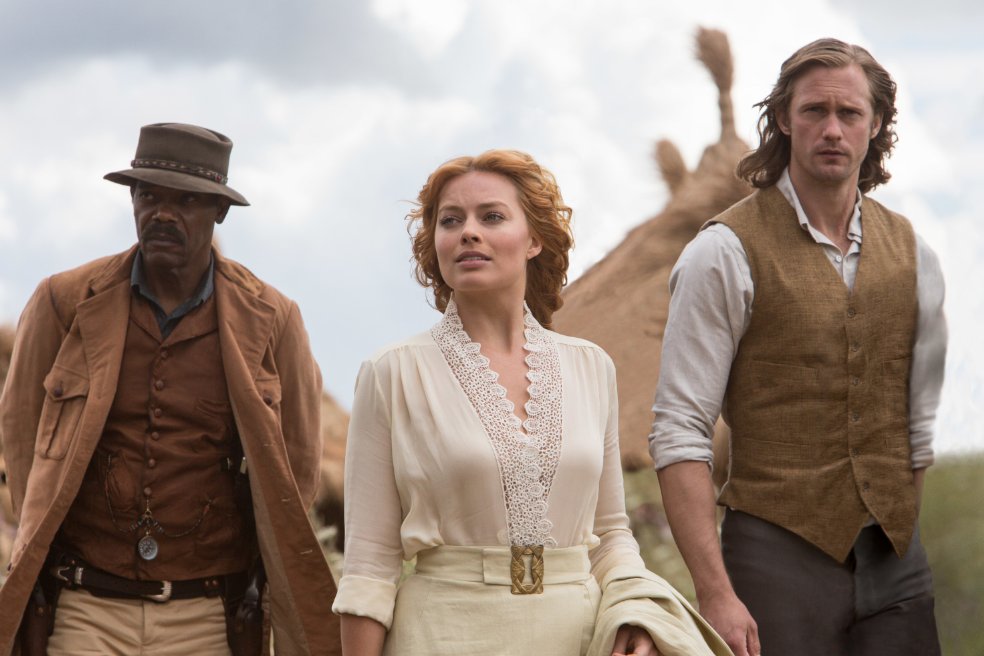Legend of Tarzan, The (United States, 2016)
July 01, 2016
In 2016, one wonders whether there’s a place in cinema for the 104-year old Tarzan. To make the character more relevant to a modern audience, screenwriters Adam Cozad and Craig Brewer, along with director David Yates (who helmed the final four Harry Potter movies), have re-imagined Tarzan as a late 19th century superhero while keeping Edgar Rice Burroughs’ background material intact. The Legend of Tarzan is an original adventure. It is not an origin story, although occasional flashback sequences effectively fill in the title character’s history.
A ripped Alexander Skarsgard plays Tarzan (a.k.a. John Clayton, Viscount Greystoke) with a little more intelligence and sophistication than Johnny Weissmuller or Miles O’Keefe. Skarsgard’s interpretation brings brain and brawn to the part. Likewise, this movie’s Jane (Margot Robbie, once again using her excellent American accent) is strongly influenced by 21st century sensibilities - she’s feisty, forthright, and definitely not a traditional damsel-in-distress. Samuel L. Jackson plays Tarzan’s sidekick, George Washington Williams, pretty much the way he plays most Samuel L. Jackson characters (albeit with a PG-13 neutering factor in place). And Oscar-winner Christoph Waltz, portraying bad guy Captain Rom, carries over most of his sneering and other evil mannerisms from Spectre. He’s Blofeld of the Jungle.
 After a prologue that explains why Rom wants to catch Tarzan, the movie provides a semi-convincing reason for Viscount Greystoke to leave behind his estate and return to the lands where he grew up. Jane, not content to sit around and let her husband have all the fun, decides to accompany him. Also along for the ride is the American Williams, a representative of President Benjamin Harrison, who believes the King of Belgium might be promoting slave labor in the Congo. Soon after their arrival, they are ambushed. Jane is captured and Tarzan is nearly killed. He spends the rest of the film chasing after her although she is by no means a model prisoner, spitting in Rom’s face, trying to assault him during dinner, and running away.
After a prologue that explains why Rom wants to catch Tarzan, the movie provides a semi-convincing reason for Viscount Greystoke to leave behind his estate and return to the lands where he grew up. Jane, not content to sit around and let her husband have all the fun, decides to accompany him. Also along for the ride is the American Williams, a representative of President Benjamin Harrison, who believes the King of Belgium might be promoting slave labor in the Congo. Soon after their arrival, they are ambushed. Jane is captured and Tarzan is nearly killed. He spends the rest of the film chasing after her although she is by no means a model prisoner, spitting in Rom’s face, trying to assault him during dinner, and running away.
 There’s an element of subtle brilliance in the screenplay that has nothing to do with the chases, fight scenes, and animal interaction. The last thing any viewer would want to see in The Legend of Tarzan is another re-interpretation of the feral child’s origin story. We’ve gone down that road countless times in versions as diverse as a Disney cartoon (1999’s Tarzan) and a soft-core porn retelling (1981’s Tarzan, the Ape Man). The difficulty for a new Tarzan movie, however, is that the backstory is necessary to establish aspects of the characters and their relationships that we may be unfamiliar with. The Legend of Tarzan solves this conundrum by giving us highlights of the character’s history via strategically placed flashbacks. They are seamlessly incorporated into the main narrative and never seem intrusive or awkward.
There’s an element of subtle brilliance in the screenplay that has nothing to do with the chases, fight scenes, and animal interaction. The last thing any viewer would want to see in The Legend of Tarzan is another re-interpretation of the feral child’s origin story. We’ve gone down that road countless times in versions as diverse as a Disney cartoon (1999’s Tarzan) and a soft-core porn retelling (1981’s Tarzan, the Ape Man). The difficulty for a new Tarzan movie, however, is that the backstory is necessary to establish aspects of the characters and their relationships that we may be unfamiliar with. The Legend of Tarzan solves this conundrum by giving us highlights of the character’s history via strategically placed flashbacks. They are seamlessly incorporated into the main narrative and never seem intrusive or awkward.
When it comes to recycling heroes of yesteryear, The Legend of Tarzan does a considerably better job than 2013’s misfire, The Lone Ranger. The Tarzan film isn’t as obsessed with pyrotechnics and special effects. There are some of both but they aren’t excessive. The movie is respectful of its source material and takes the characters seriously, although there’s room for some humor (most of it coming from Samuel L. Jackson, who at times seems to be playing the Danny Glover role in lethal weapon - “I’m too old for this shit”).
 The Legend of Tarzan’s camerawork includes long, unbroken shots where the camera moves to capture the action rather than cutting. It’s impossible to tell whether all the vine-swinging comes from stunt doubles or CGI (probably a mixture of both) but it’s exhilaratingly presented. The creature work is expertly done, making it difficult to determine which animals are real (if any), which are animatronic, and which are computer creations. The Legend of Tarzan is a lot like The Jungle Book in that respect, although in this movie no talking bears start singing.
The Legend of Tarzan’s camerawork includes long, unbroken shots where the camera moves to capture the action rather than cutting. It’s impossible to tell whether all the vine-swinging comes from stunt doubles or CGI (probably a mixture of both) but it’s exhilaratingly presented. The creature work is expertly done, making it difficult to determine which animals are real (if any), which are animatronic, and which are computer creations. The Legend of Tarzan is a lot like The Jungle Book in that respect, although in this movie no talking bears start singing.
The Legend of Tarzan moves briskly and has the overall feel of one of Burroughs’ more entertaining stories come to the screen. (It has often been acknowledged that, despite Tarzan’s popularity, his pulpy adventures don’t represent the height of literary achievement.) The film is nicely positioned so that, if it does well at the box office, it could spin off a sequel with little difficulty. More importantly, if the reception is tepid, it stands well on its own, needing no second installment to validate its existence. Unlike so many of the bloated, disappointing entries into the 2016 big budget sweepstakes, this is good escapist entertainment.
Legend of Tarzan, The (United States, 2016)
Cast: Alexander Skarsgård, Margot Robbie, Samuel L. Jackson, Christoph Waltz, Djimon Hounsou, Jim Broadbent
Screenplay: Adam Cozad and Craig Brewer, based on the “Tarzan” stories by Edgar Rice Burroughs
Cinematography: Henry Braham
Music: Rupert Gregson-Williams
U.S. Distributor: Warner Brothers
U.S. Release Date: 2016-07-01
MPAA Rating: "PG-13" (Violence, Profanity, Sexual Content)
Genre: Adventure
Subtitles: none
Theatrical Aspect Ratio: 2.35:1
Comments